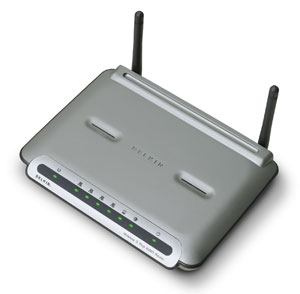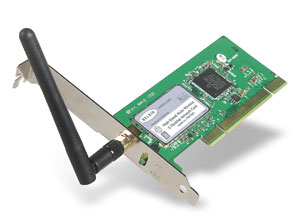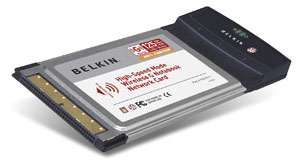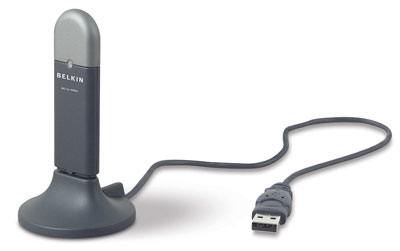|
Wireless (WiFi) Devices from Belkin
by Tim J. Summers
Preface.
About every 18 months some computer hardware or software takes a giant step, catches our fancy and turns out to be a very useful advance. Wireless, now commonly referred to as WiFi has come full circle with a faster version of 11.g or simply the "g" version. (A new version, "11.n" is arriving, but wait until there is a standard "n" - currently, there is no standard.) Although speed does not always play an important role in our computations, if you look at the wider implications, in WiFi it is very important. It is quickly becoming a full fledged communications system, replacing all those darn wires. It is already implemented by sending videos from our computers across the house to your TV or music from an MP3 player to the patio or bedroom, or pictures from your phone to a printer.
How about next we just do away with wires and turn on and change the setting on the microwave? Or, the outdoor lights? Or, better still start the car after work and let the A/C cool it down. Well, you see where I, rather we, are going. There are as yet unresolved issues such as security of each "transmission" and compatibility.
And you know, for a basic system, it just isn't that expensive. It's fairly simple to learn how to "install" your own WiFi network.
Enjoy.
Charles W. Evans, Reviews Editor
The Belkin Router: G Plus, High Speed Model 7231-4
 So why did my company go WiFi when it would have been easier to run wires through the ceiling? Just that reason: get rid of the wires and build-in flexibility. I assembled and installed a separate system at my company using these four Belkin devices. I learned two things. Belkin is a cost efficient (less costly), but not as speedy as some of the better known brands. In my company's case, we have many gigs of data/video to move into storage, so speed feature #1. In most applications, the sort of speed we need is not required - even to transfer home videos. So why did my company go WiFi when it would have been easier to run wires through the ceiling? Just that reason: get rid of the wires and build-in flexibility. I assembled and installed a separate system at my company using these four Belkin devices. I learned two things. Belkin is a cost efficient (less costly), but not as speedy as some of the better known brands. In my company's case, we have many gigs of data/video to move into storage, so speed feature #1. In most applications, the sort of speed we need is not required - even to transfer home videos.
The "router" connects to your computer and directs or routes signals to other receiving devices called "adapters". I'm especially impressed with its browser based installation wizard. The wizard and an actual printed User Manual are atypical now days. I must confess, the router, which is the heart of a WiFi system, was easy to setup. The CD based wizard takes your digital hand and the on-screen menu will, for example, say: "now plug power cord in". There's even a sticker over the router ports warning you to run the setup wizard before connecting any cables. For instance, I have the Belkin hooked to my computer's internet port. Any of the other three Belkin receivers or adapters can access the internet through that router IF, IF, IF they have the correct ID and password. My strong suggestion: write down your case sensitive password and ID BEFORE you enter it. These things are not very forgiving. And this is part of your security.
The install CD takes you through quite a number of settings, most of which you can simply accept the default entries. Carefully read the first part of each major menu. There are no trick questions, but in the case of Belkin, their router also can act as an adapter and if you respond to the settings in the adapter thinking that you are on the router menu you'll go nowhere very quickly. It isn't difficult, but you cannot do it between coffee and cake. In most cases the choices are very obvious and if not to you, there's a thoughtful "help" button and lots of support at their web site or e-mail or toll-free phone plus a searchable PDF manual on the CD. They are serious about wanting you to find their devices easy to set up and useful.
This router is "G Plus" because it is version "g" with an advanced chip set that, in an open parking lot, will just about double the 54Mbps speed to 108Mbps - theoretically that is. In a more practical, interior environment, you might expect closer to 65Mbps which is still better than the original 54Mbps that drops to about 25Mbps.
For most of the technical stuff go to their web site. I'm reviewing the product not the specs. I do want you to know that both the router and desktop PCI card adapter work with Apple's AirPort drivers so it is compatible with older MACs and are less expensive than Apple's adapters and compatible with AppleTalk. We are all admonished to use a firewall and generally we use a software one. This router has a built-in hardware firewall - better than software. Its features include: WPA2, PSK and 64 WEP/128 bit encryption.
As for connectivity, the router has four 10/100 Ethernet ports, one RJ-45 autosensing, WAN and LAN ports. Although we don't need this in our company, parents should be aware of a very strong optional parental control system, which filters all Web traffic for objectionable content in categories ranging from adult and violent games. Not a unique feature, but rare.
Where the setup wizard falls down, it assumes that you are connected directly to the Internet from your current computer, and then tries to detect/copy your connection information that way. So work with that issue. Just return to the basics and it will be no problem. I mentioned there are extensive menus and I suggest accepting most of the defaults. I do have preferences. Under the WAN>Connection Type I prefer a "dynamic" selection and under the Wireless>Channel and ID, I specify a specific channel and high encryption.
Support is 24/7 and also at www.belkin.com/support. For a SOHO or home user this is a good value. The feature list is extensive although the speed and distance are mediocre, you are not trying to transmit through two foot, steel reinforced walls. This fast G is a good choice and even the most uninitiated can install the network. Buy it, install it and don't look back. OK, OK the next day when you are riding your mower and working on your laptop, and have a fake antenna sticking out of your gimmie cap, you can look a bit smug as your neighbors see how smart you've become!
The Belkin Adapters: PCI Card, PC Notebook Card and USB
Since these adapters are fairly "dumb", there's not much to evaluate, except: the same, friendly, easily understood browser set up wizard is unique to each device. The USB adapter is NOT the G Plus, but is the standard 11.g at 54Mbps or about 25Mbps in practice.
 This adapter is rated at 108Mbps. Take that with a grain of salt - it'll be more like 65Mbps, which is still fairly quick. It is a 32bit PCI card. Just follow the install wizard and will tell you when to physically install the card and how to configure it. Generally, it is a matter of a few settings and parameters, selecting the network you'll want to connect to. It has the same security options as the mother ship, the router. AND you'll need to enter the ID and password used in the router set up or, again, you'll go nowhere very quickly. This adapter is rated at 108Mbps. Take that with a grain of salt - it'll be more like 65Mbps, which is still fairly quick. It is a 32bit PCI card. Just follow the install wizard and will tell you when to physically install the card and how to configure it. Generally, it is a matter of a few settings and parameters, selecting the network you'll want to connect to. It has the same security options as the mother ship, the router. AND you'll need to enter the ID and password used in the router set up or, again, you'll go nowhere very quickly.
There's plenty of help on the CD, but I especially appreciate the well organized printed manual. I would call Belkin's attention to the menu illustrations - not easily read since they are in grey ink and tiny type - come on Belkin! The manual takes you through each step, has call out balloons to further explain an entry, etc. Couldn't be easier or friendlier. The theoretical range is 700' - inside its about 75-150 feet.
 Ditto for this adapter. Same speed and specs as the PCI Card. Use its unique browser based install wizard, then insert the device into an empty PC slot, wait a minute then respond to a few questions and settings and finally, select the network. Again, you'll need the routers ID and password. You cannot do a thing without those two entries. Ditto for this adapter. Same speed and specs as the PCI Card. Use its unique browser based install wizard, then insert the device into an empty PC slot, wait a minute then respond to a few questions and settings and finally, select the network. Again, you'll need the routers ID and password. You cannot do a thing without those two entries.
You can further protect your system by turning ON/OFF the "radio", meaning access to your adapter. There's a menu to add or delete networks. We have two networks, so I keep both. In a SOHO or family environment, I'd keep the number of "available networks" to a minimum and keep that firewall UP, way up. Otherwise, if you use a hot spot in a public area, anyone can read your computer and transmissions. A little paranoia is helpful. Range? About the same as the PCI Card.
 This use is a bit different. It is the standard 54Mbps (in practice, about 25Mbps) and has a "parking lot" range of 400' or inside about 30-60'. What I like about USB is that it can be plugged into the back of your computer (laptop or desktop) or use it on the included antenna stand. The stand is rather poorly designed. It is light weight and the connecting wire snaking out from underneath reduces the stability of the base - Belkin: work on this, real hard. This use is a bit different. It is the standard 54Mbps (in practice, about 25Mbps) and has a "parking lot" range of 400' or inside about 30-60'. What I like about USB is that it can be plugged into the back of your computer (laptop or desktop) or use it on the included antenna stand. The stand is rather poorly designed. It is light weight and the connecting wire snaking out from underneath reduces the stability of the base - Belkin: work on this, real hard.
Just like its big brothers/sisters, the browser install wizard makes its use a cinch. Again, just plunk the CD in, follow the directions (including when to plug the USB adapter in), type in a few settings and/or parameters. I've often thought USB as one of the better PC "inventions" - great flexibility and portability. The antenna base has about a 30" cable so you can put it up and out of the way for maximum transmission distance and minimum interference. It is backwardly compatible to version 11.b and USB vs. 1.0. If you don't have a USB2 port, don't get this device. It doesn't make sense to use a 54Mbps adapter on a 10Mbps port! It's 2006, what are you doing with a USB1 port?
Belkin is a good value; it is feature rich and easily installed. I only wish it was a bit speedier and could transmit over a longer distance. For most uses it is quite adequate. Except for the desktop PCI card, every other device has a large driver update. Drop by www.belkin.com and see what you think. It has been a very nice experience to evaluate hardware by a vendor who puts a lot effort in helping the end user. Thanks, Belkin.
Tim J. Summers is a HAL-PC member who is the "go to guy" for wireless at a locally headquartered data security company. He installed their WiFi system two years ago.
|

